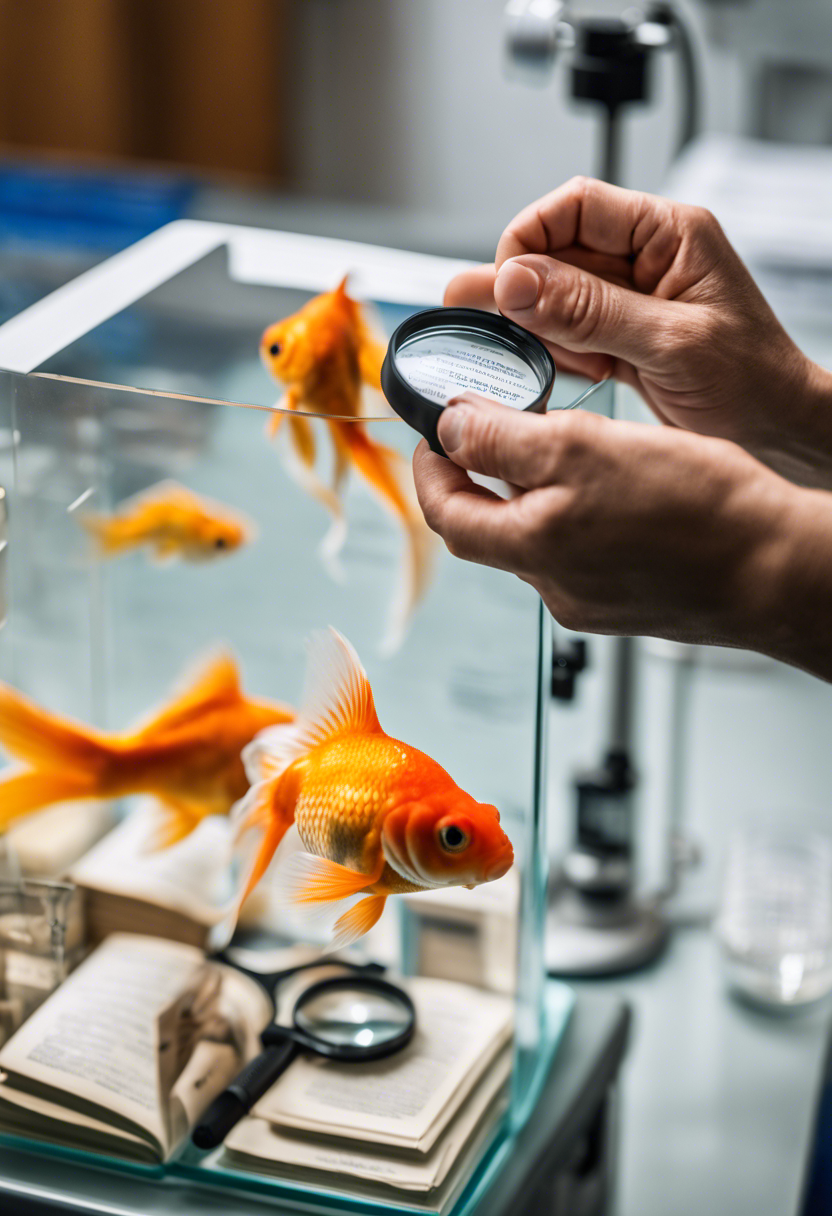Ever found yourself gazing at your goldfish and wondering, “What’s up with you, buddy?” Well, it could be one of those pesky Goldfish Diseases.
Don’t worry! We’re here to help you diagnose and treat these common ailments that can turn your fishy friend’s world upside down. So buckle up and let’s dive in!
“Keep reading about Goldfish Diseases: Diagnosis and treatment”
Key Takeaways
- Goldfish diseases can be diagnosed through observing changes in behavior, physical abnormalities, and water testing.
- Common diseases include Swim Bladder Disease, Ich (White Spot Disease), and Fin Rot.
- Treatment varies by disease but often involves adjusting water conditions, administering medication, or in severe cases, surgery.
- Preventative measures such as regular tank cleaning and proper feeding can help avoid many common goldfish diseases.
What are the Common Diseases in Goldfish?
When it comes to goldfish diseases, our little aquatic pals can unfortunately catch a few. We’re talking about common goldfish illnesses that range from the pesky Ich to the dreaded Dropsy. And let’s not forget those nasty fungal infections! But don’t worry, we’ll dive into each of these prevalent goldfish ailments one by one.
Ichthyophthirius Multifiliis (Ich)
First up is Ich, or as scientists call it, Ichthyophthirius Multifiliis. It’s like the common cold for fish, but a bit more serious. If your goldie starts showing white spots and seems itchier than usual, you might be dealing with Ich in goldfish. The diagnosis? Usually done by observing these symptoms and sometimes confirmed with a microscope.
Fin Rot
Next on our list is Fin Rot. This is when your goldfish’s fins start looking raggedy or even disintegrating – yikes! That’s right folks, fin rot in goldfish is no joke. It’s usually diagnosed by spotting these physical changes early on.
Dropsy
Dropsy sounds cute but trust me, it ain’t! It’s when your fish gets bloated and its scales stick out – not a pretty sight. This is another one of those goldfish health issues that can be identified through visible symptoms.
Swim Bladder Disease
Ever seen a fish swimming sideways or upside down? No, they’re not just being silly – they could have Swim Bladder Disease! This condition messes with their buoyancy control and can be diagnosed by observing unusual swimming patterns.
Fungal Infections
Last but not least are fungal infections. These sneaky things cause fluffy white patches on your fish’s skin or gills – like they’ve been rolling in powdered sugar! But don’t be fooled, fungal infections in goldfish are serious business and can be diagnosed by spotting these symptoms.
How to Diagnose Goldfish Diseases?
Diagnosing goldfish diseases early and accurately is a fish owner’s best defense. It involves keen observation of physical symptoms, monitoring behavioral changes, and conducting water quality tests.
Observing Physical Symptoms
Physical symptoms are often the first signs of trouble in goldfish. A healthy goldfish should have vibrant colors and smooth scales. If you notice your fish looking dull or its scales starting to protrude, it’s time to start worrying about common goldfish diseases.
Changes in the eyes can also be a sign of sickness. Cloudy or bulging eyes might indicate an infection. Also, watch out for any unusual growths or spots on your fish’s body as they could be signs of parasitic infections.
Monitoring Behavioral Changes
Behavioral changes can also signal that something is amiss with your goldfish. A healthy goldfish is active and has a good appetite. If your fish starts acting lethargic or loses interest in food, it might be feeling under the weather.
Another sign of stress in goldfish is erratic swimming patterns. If your usually graceful swimmer starts darting around the tank or swimming upside down, it could be a sign of illness.
Conducting Water Quality Tests
Water quality plays a crucial role in maintaining the health of your goldfish. Poor water conditions can lead to a host of health problems for your finned friend.
Regularly testing aquarium water helps detect potential issues before they become serious problems. High levels of ammonia or nitrate, for example, can cause respiratory distress in fish.
Remember folks, prevention is better than cure! So keep an eye on those adorable little swimmers and maintain top-notch water conditions to ensure their well-being.
What are the Treatment Options for Goldfish Diseases?
When it comes to treating goldfish diseases, there’s a whole range of options. We’re talking about both medication and non-medication treatments. Let’s dive into each one, shall we?
Medication Treatments
Medication treatments, like antibiotics, antiparasitics, and antifungals, can be real lifesavers when dealing with sick goldfish. These goldfish medication treatments are designed to target specific types of infections.
Antibiotics
Antibiotics are the go-to for bacterial infections in goldfish. They work by killing off the nasty bacteria causing all the trouble. When used correctly, these goldfish antibiotics can help your fishy friend bounce back in no time.
Antiparasitics
Parasites got your goldfish down? That’s where antiparasitic medications come in. These bad boys target those pesky parasites wreaking havoc on your fish’s health. With proper use of these antiparasitics for goldfish, you’ll have your pet swimming happily again soon.
Antifungals
Fungal infections can be a real pain in the gills for goldfish. But don’t worry! Antifungal medications are here to save the day. By targeting and eliminating the fungus, these antifungals for goldfish can help restore your pet’s health.
Non-Medication Treatments
But what if you want to avoid meds? Well, there are non-medication treatments too! Things like quarantine procedures and improving water quality can also help treat goldfish diseases.
Quarantine Procedures
Quarantine procedures aren’t just for humans! They’re an effective way to prevent disease spread among goldfish too. By isolating sick fish from healthy ones, you can stop a small problem from becoming a big one.
Water Quality Improvement
Last but not least, let’s talk water quality. Improving the water your goldfish swim in can do wonders for their health. Clean, well-maintained water can help prevent and treat diseases, making it a key part of goldfish disease prevention. So remember folks, keep that tank clean!
How to Prevent Goldfish Diseases?
When it comes to maintaining goldfish health, prevention is the name of the game. It’s all about creating a healthy environment and lifestyle for your finned friends. Let’s dive into the details.
Maintaining Proper Tank Conditions
First up, let’s talk goldfish tank maintenance. You see, goldfish are pretty particular about their living conditions. They need just the right optimal water temperature. Too hot or too cold can stress them out, leading to illness.
Keeping their aquarium clean is also crucial for goldfish disease prevention. Dirty water can breed bacteria and parasites, which are bad news for your fishy pals. And don’t forget space! Goldfish love room to swim around.
Providing Balanced Diet
Next on our list is diet – a balanced diet for goldfish, to be exact. What you feed your fish plays a huge role in their health and wellbeing. Variety is key here; try different types of goldfish food like flakes, pellets, and even fresh veggies.
And remember, moderation is key when it comes to feeding frequency. Overfeeding can lead to bloating and other health issues in goldfish.
Regular Health Check-ups
Finally, we come to regular check-ups – an essential part of keeping your goldfish hale and hearty. Keep an eye out for any changes in behavior or appearance that could signal trouble.
Look out for signs like loss of appetite or changes in swimming patterns – these could be early warning signs of unhealthy conditions in your fishy friend. So there you have it folks! Prevention really is better than cure when it comes to goldfish diseases.
To Wrap Up
So, we’ve swum through the murky waters of Goldfish Diseases, like intrepid explorers in a submarine. We’ve seen it all – from Ich to Fin Rot.
But remember folks, knowledge is power! Now you’re equipped to spot these pesky diseases and treat them effectively. Keep those golden buddies swimming happily!



